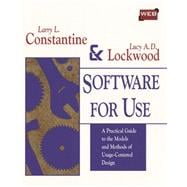
Larry L. Constantine, a pioneer of modern software engineering practice, is highly regarded as an authority on the human side of software development. A leading international lecturer, author, editor, and consultant, he has ten books and more than 120 published papers to his credit. Under the pen name Lior Samson, Larry has just published his first novel, Bashert, a political thriller set against the backdrop of Israel’s emergence as a nuclear power.
Lucy A. D. Lockwood has more than a dozen years of experience in programming and project management. An international consultant, teacher, and writer, she chairs the User Interface Design Track of the Software Development Conference.
I. TOWARD MORE USABLE SOFTWARE.
II. ESSENTIAL MODELS FOR USABILITY.
III. CREATING THE VISUAL DESIGN.
IV. COMPLETING THE DESIGN.
V. ASSESSMENT AND IMPROVEMENT.
VI. ORGANIZING AND MANAGING THE PROCESS.
The New copy of this book will include any supplemental materials advertised. Please check the title of the book to determine if it should include any access cards, study guides, lab manuals, CDs, etc.
The Used, Rental and eBook copies of this book are not guaranteed to include any supplemental materials. Typically, only the book itself is included. This is true even if the title states it includes any access cards, study guides, lab manuals, CDs, etc.